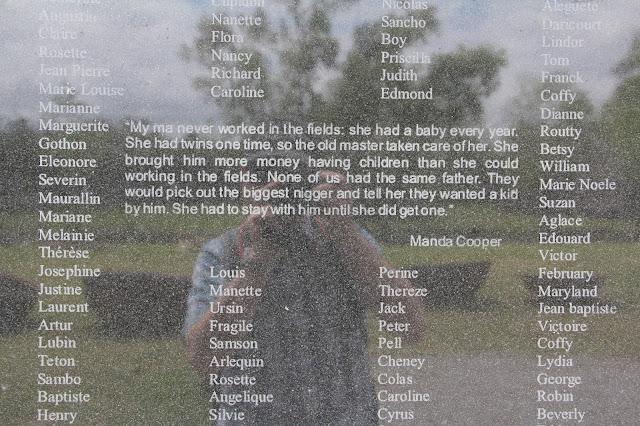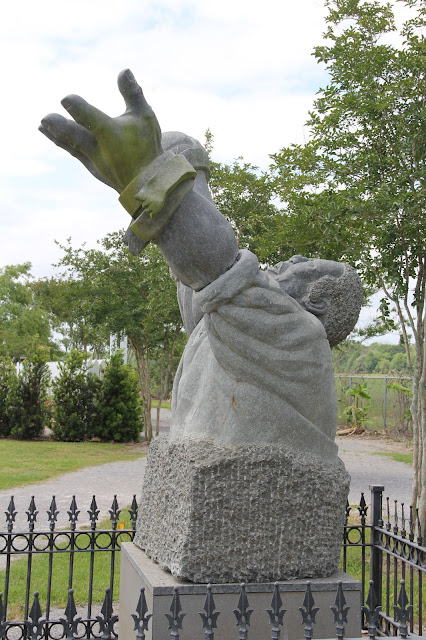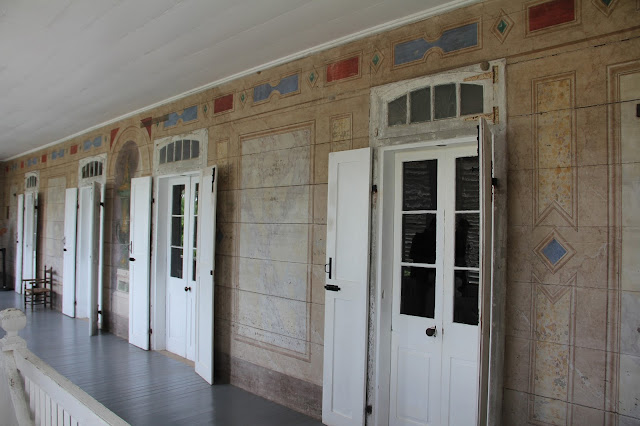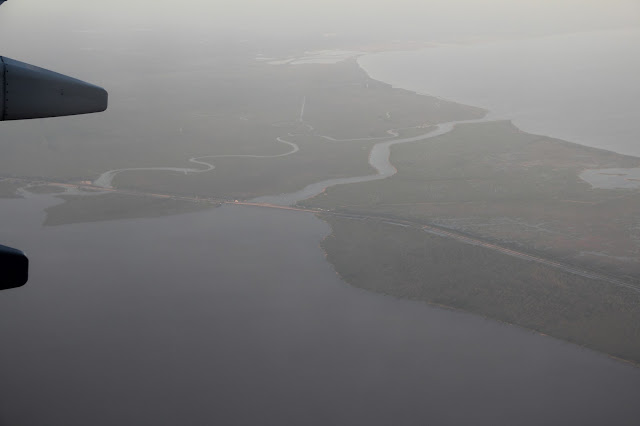
The French Quarter as viewed from the top of the Marriott.



I ate a lot of delicious food, including this shrimp jambalaya.
I gathered for a dinner with the three BYU faculty attending the conference and nine BYU geography grads, all of whom are now professors or PhD students around the country.
And I attended other paper sessions and the presidential plenary session. Of greatest interest to me on this trip were the two sessions I attended with very interesting papers on the confederate memorial debate and the plenary session on racism in New Orleans.
Quotes referring to the taking down of four confederate monuments in New Orleans last year.
The Lee Memorial.
One paper looked at ways blacks in New Orleans are trying to memorialize (via paper monuments) influential blacks from the city. The underlying point was why have blacks not been memorialized in the city.
"And it immediately begs the questions: Why there are no slave ship monuments, no prominent markers on public land to remember the lynchings or the slave blocks, nothing to remember this long chapter of our lives, the pain, the sacrifice, the shame....all of it happening on the soil of New Orleans.
...These monuments purposefully celebrate a fictional, sanitized Confederacy. Ignoring the death, ignoring the enslavement and the terror that it actually stood for..."
The mayor is ruining our city.
[He's] giving the middle finger to the citizens of this city.
They'll put a statue of Trump there now.

For the past three years at BYU I have been team teaching a course on nationalism. Each semester new issues involving nationalism were discussed (populist nationalism, Trumpism, Brexit, ethnic nationalism etc.). One of the topics from last semester's class was the whole Confederate monument debate. I therefore set out to see what I could see about monuments in New Orleans (and later Mississippi). Andrew Jackson still stands in Jackson Square in the French Quarter.
Joan or Arc still stands in front of the French Market
In Lafayette Square there is no statue of Lafayette, but there are statues honoring John McDonogh (a local educator) (front), Henry Clay (left) and Ben Franklin.
Also still standing is the first causality from Louisana in the Civil War. A fitting tribute to a local boy who was doing his duty.

No longer standing is the statue of Jefferson Davis, President of the confederacy. All that remains is the pedestal. This is located just across Canal Street from the Dreux statue shown above.
Source: https://en.wikipedia.org/wiki/Jefferson_Davis_Monument
Last fall a statue of a black woman was temporarily placed on the pedestal of Jefferson Davis. I learned about this statue in one of the sessions. I didn't know how temporary the placement was (it was only to make a music video) so I ventured out to find the woman only to find out the pedestal empty once again.
http://www.nola.com/arts/index.ssf/2017/11/jefferson_davis_monument_video.html
The next day I sought out the empty pedestal where Robert E Lee (who never set foot in New Orleans) once stood.

The Jefferson Davis monument was dedicated in 1911, the Lee monument in 1884. Research by the Southern Poverty Law Center shows a timeline of when all of the Confederate monuments were erected. Most were around the turn of the century during the height of the Jim Crow era which suggests that there were racist motives involved and not just a desire to honor Civil War soldiers.
https://www.splcenter.org/20160421/whose-heritage-public-symbols-confederacy
One morning I went to breakfast (grits and cajun shrimp) with a good friend from graduate school and his wife (all three of us did dissertation research in Israel/Palestine at the same time). Afterwards I joined them for a walking tour of the French quarter.
I returned to the French Quarter the next afternoon to check out the music at the French Quarter Festival.
St John the Baptist Parish Church.
On Friday morning I rented a car and headed out for a three day road trip. First stop was Whitney Plantation about 45 minutes west of New Orleans in St John's Parish. It is a plantation where everything is told from a slavery point of view. I read about it last year and put it on the top of my New Orleans to-do list. I highly recommend it. This Smithsonian article gives a great overview of what the plantation is about and what can be seen.
https://www.smithsonianmag.com/history/inside-americas-auschwitz-180958647/

The 90 minute guide tour begins in the Antioch Church (named for an early Christian center that veils the real name of the church-- Anti-Yoke--which was founded by former slaves who were against the yoke of slavery).
Much of the tour focuses on the stories of slave children. Statues of children are found throughout the plantation. They commemorate the thousands of children who died on the plantations of St. John's Parish. They also commemorate the thousands of stories collected by a US government program during the Depression to record the stories of the last generation of living slaves. These slaves in their 80s and 90s told what it was like to be a salve.

The Wall of Honor monument memorializes by name all of the people who were enslaved on Whitney Plantation.
Some slaves maintained their African name (which provide links to native tribe and religion) but most received new names.

Interspersed among the names are stories told as part of the Federal Writer's Project where former slave children were interviewed.




Field of Angels Coming Home By Rod Moorehead




Memorial to those slaves who died in the German Coast Uprising.

Slave cabins.
Sugar cane carts and fields in the distance.

The kettles were used to crystallize the sugar.
Slave jail.
The big house. The tour of the house was very brief.
Carriage house
Cook house.
Our guide and group. The information presented and the stories told were eye-opening and sobering. Such a tragic part of American history that still impacts society today.
Cisterns to catch rain water.
The upper veranda that looks out on the slave cabins.
Sugar cane still grows in the fields surrounding the plantation.
Mississippi waters, levee and sugar cane.

I then headed north to Natchez Mississippi.

It is named after the Natchez Indians (why do I not remember ever hearing about this Native American tribe?) who built ceremonial mounds in the area.

Great Sun's Mound and Temple Mound at the Grand Village of the Natchez.
I then headed north along the beautiful tree-lined Natchez Trace Parkway to Emerald Mound--the second largest Mississippian Period ceremonial mound in the US.
I exited the parkway near Jackson Mississippi and then drove further north on I-55 to Batesville where I stayed the night.
Next morning I drove to Memphis in the rain. My primary purpose in coming to Memphis was to visit the National Civil Rights Museum which is housed in the Lorraine Motel where Martin Luther King was assassinated fifty years ago this month. Like Whitney Plantation is is well worth a visit. Given the still troublesome status of race relations in America I think every American should put these two places on their must visit list.
The wreath marks where King was standing when he was killed.
The museum starts with an exhibit (no photos allowed) of King's life and legacy. It then shifts to slavery.
Exhibits then focused on migration out of the south and the racist policies and attitudes the lasted for almost a century after the Civil War.
The focus of the majority of the museum is then on the civil rights movement.

Rosa Parks and me.
The freedom ride was one of my favorite forms of protest. National laws forbade segregation on interstate buses and in bus stations so blacks set out to ride buses through the south to expose local racist laws. Southerners resisted which only served to publicize more widely southern segregation.
Violence ensued.
Blacks boycotted, walked, rode, sang and sat their way to freedom.
When adults were detained, children took up the banner.
Six children were killed in one of the bombings in Birmingham.
This graph of blacks elected to public office shows the short lived participation of blacks after the Civil War followed by the decline during Jim Crow.
Martin Luther King stood not only for civil rights, but for broader human rights, an end to the Vietnam War and for the uplifting of the poor. He came to Memphis to lend support to sanitation workers who were grossly underpaid and treated.
The night before he was assassinated he gave he last speech: "I've been to the mountaintop."
View excerpts here: https://www.youtube.com/watch?v=Oehry1JC9Rk "We as a people will get to the Promised Land!"
King's motel room.

Next stop was the Mississippi River Museum on Mud Island adjacent to downtown Memphis.
One of the exhibits highlights all of the various genres of music that have developed in the Mississippi River valley.
Most exciting to me was a model (extending perhaps 100 yards) of the lower Mississippi with every bend from the Gulf of Mexico to Cairo Illinois.

Where the river meets the gulf.
New Orleans
Memphis
Confluence of the Ohio (right) and the Mississippi at Cairo.
Ohio River
Missouri River
I was hustling to leave as cold and rain moved in when I noticed two barges heading up the river so I stayed to watch. At one point it seemed as if the larger barge to the rear was going to ram the small and slower forward barge.
Memphis barbecue for dinner then back to Batesville.
The Mississippi Delta
Sunday morning I headed out to explore the Mississippi Delta--known for its cotton growing and for where the blues were born.
A modern day cotton gin.
The fighting Okra of Delta State University in Cleveland.
Beulah from the levee.
Levee bank
Benoit
Another Gin.
Lots of small Missionary Baptist Churches and Church of God in Christ in rural Mississippi. If I had had more time I would have stopped in and enjoyed the service.
Greenville
Cotton themed utility box.


Confederate Monument at the Court House. I knew there was a monument (thanks google for helping me find a list of monuments in Mississippi) in front of the county courthouse (no thanks goggle maps for not showing the courthouse) but it took some driving around town to finally find it.
Erected in 1912.
The words speak for themselves. This is not a monument just to honor loyal soldiers, it is a memorial to the former south where enslaved blacks were an accepted part of everyday life. States Rights is how it was framed, but the right each state was fighting for was the right for slavery to continue. Memorials like this exist as if slavery never happened. They offer no healing from its horrors and lasting legacy. Mississippi has passed a law making it illegal to remove any confederate monuments like this.
Mississippi is the only state to incorporate the Confederate Battle Flag into its flag. Georgia added the Stars and Bars to its flag during the civil rights battle and then removed it when the Olympics came to Atalanta. Some southerners see the Stars and Bars as a sign of heritage and southern pride, others see it as a racist remnant of a time when Blacks lacked civil rights. I side with the latter.
Interstate 10.
Northwestern New Orleans, Lake Pontchartrain and the protective levees that failed during Katrina.
I-55 cutting between Lake Pontchartrain and Lake Maurepas (left)
The mighty Mississippi.




































































































































































Good to know.
ReplyDelete